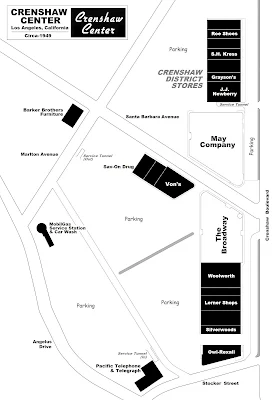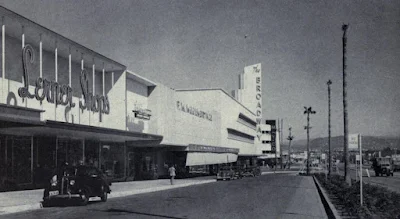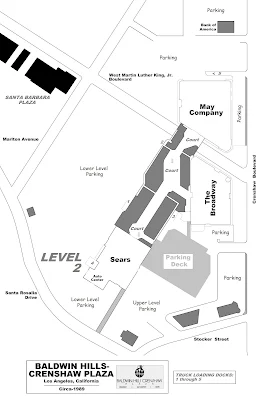CRENSHAW CENTER TENANTS 1949:
THE BROADWAY (with beauty salon, public auditorium and garden center) / F.W. WOOLWORTH 5 & 10 (with luncheonette) / Alpert's Fabrics / Arthur Murray Dance Studio / Children's department store / Lerner Shops ladies' wear / Leeds Qualicraft Shoes / Owl-Rexall Drugs / Sav-On Drugs / Security-First National Bank / Silverwoods apparel / Von's Market (with fountain luncheonette)
OUTPARCELS:
Barker Brothers Furniture / MobilGas service station & car wash / Pacific Telephone & Telegraph accounting office
CRENSHAW DISTRICT TENANTS 1949:
MAY COMPANY (with coffee shop, children's playroom, children's barber shop, sewing school and public auditorium) / J.J. NEWBERRY 5 & 10 (with luncheonette) / S.H. KRESS 5 & 10 (with luncheonette) / Grayson's ladies' wear / Kay Jewelers / Richman Brothers men's wear / Roe Shoes
In a northward CRENSHAW CENTER view, we see Lerner Shops, Children's Department Store, Woolworth's and The Broadway. The May's Crenshaw building appears in the distance.
Photo from "California Highways & Public Works" magazine / May-June 1948
Desmonds, a Los Angeles-based clothier, opened a CRENSHAW CENTER store in March 1953. It took the place of a shuttered Owl Rexall Drugs.
Drawing from Desmonds, Incorporated
By the 1980s, CRENSHAW CENTER had been eclipsed by newer, fully-enclosed- shopping venues in its trade area. Here we see a dowdy-looking section of the strip center, as it appeared in its final days.
Photo from www.theotherstream.com / Richard Longstreth
Photo from www.theotherstream.com / Richard Longstreth
Most of the 1940s-vintage shopping center was demolished in the late 1980s, leaving its two anchors intact. These were worked into a 2-level, fully-enclosed mall, which extended over West Martin Luther King, Jr. Boulevard and connected into the May Company store on the north side. A new name for the complex was bestowed; BALDWIN HILLS-CRENSHAW PLAZA.












